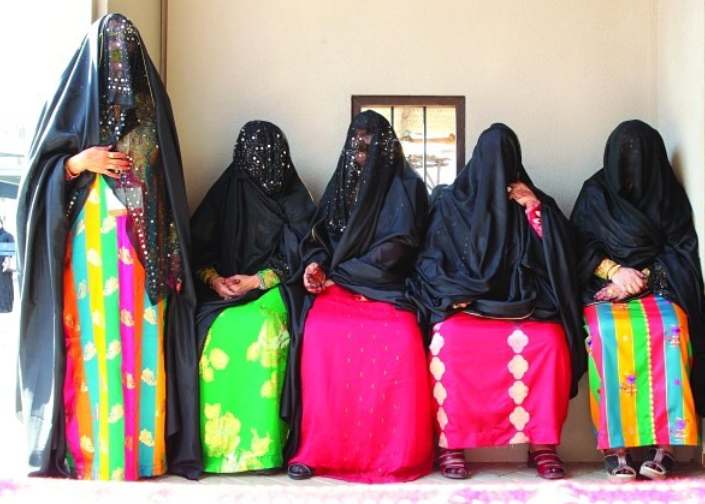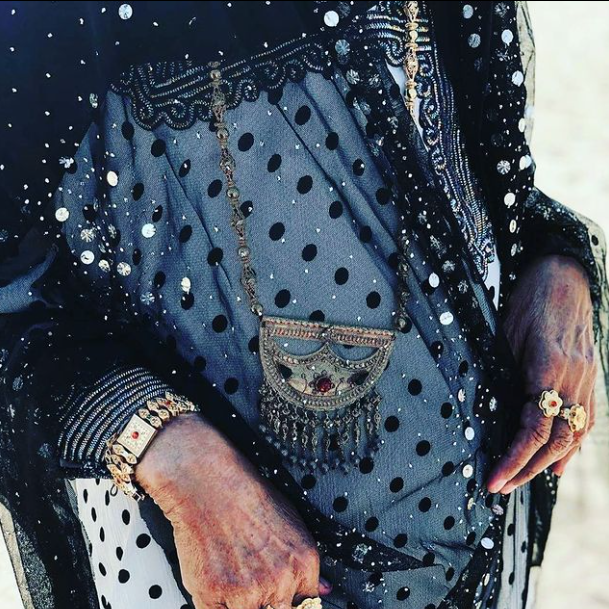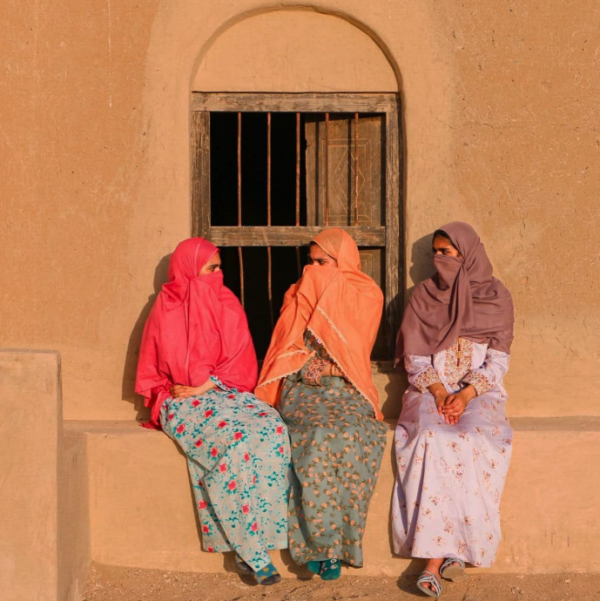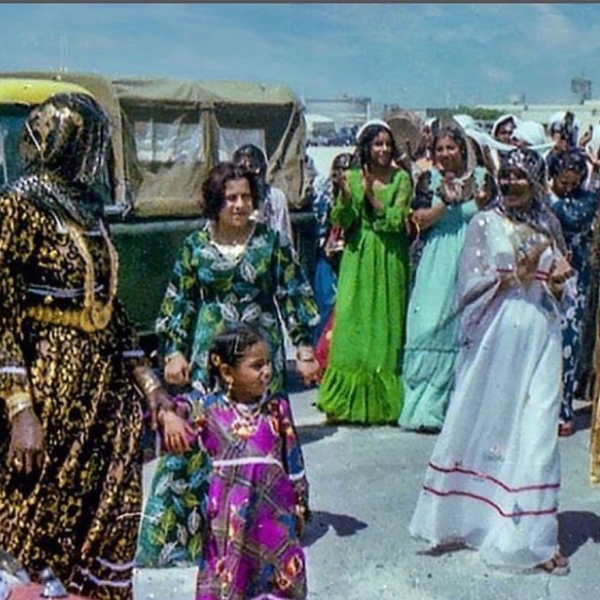This article is based on Dr. Reem el Mutwalli’s book
Sultani
Sulṭānī: (Arabic: sultān: king). In the UAE the term denotes to silk satin fabric in multiple vertical striped colours, commonly used for tunics (kanadir) and underpants (sarāwīl). Also refers to book: Sultani, Traditions Renewed, Changes in women’s traditional dress In the United Arab Emirates during the reign of the late Shaykh Zāyid Bin Sultan āl Nahyān, 1966-2004, By Dr. Reem Tariq
Ṭariq: (Arabic; Synonym: tulle_bi_talli
Tūlle_bi_tallī: (French: Tulle – a city in France where fine material for veil was first made; Turkish: tel – wire; Synonym: tariq; talli; badla; khus_dozi ), series of small metal knots made on a woven net ground as embellishment. The term is commonly used in the North African Arab region specifically in Egypt.
; talli; badla; khus_dozi ), series of small metal knots made on a woven net ground as embellishment. The term is commonly used in the Levant Arab region specifically in Lebanon.
El Mutwalli (2011).: Traditions Renewed. Changes in women’s traditional dress in the United Arab Emirates during the reign of the late Shaykh Zayid Bin Sultan Al Nahyan, 1966-2004, which, in turn, is based on her PhD thesis in Islamic Art and Archaeology obtained from SOAS, University of London, UK, in 2007. Inspired by The
Zay
Zay: (Arabic: costume, Pl. azyaā’), a set of clothes in a style typical of a particular country or historical period. Initiative’s exhibition called
Bū Tīlah wa Bū Glaym: Spots & Stripes at Zaman Awal in The Mall of the Emirates which focuses on examples of two forms of fabrics traditionally favoured in articles of UAE traditional dress. Here we give an overview of a wide range of fabrics and textiles traditionally used for women’s clothing in the UAE.

The role of textiles in traditional UAE culture
Throughout centuries and across cultures, textiles are more than a form of protection and decoration, it has become a language telling stories of culture, society, politics, economics, trade, and economics, as well as stories of natural resources, agriculture, technology, craft, artisanship, and above all else, fashion and trends.
Although the Arab world has a rich history of textile production – think Egyptian cotton and Syrian
Damask
Dāmāsk: (Arabic: Damascus – a city in Syria), is a luxurious fabric woven with reversible patterns typically in silk, wool, linen, or cotton. Originating in China, the fabric was perhaps introduced to European traders at Damascus – a major trading post on the Silk Road with a thriving local silk industry. – most of the fabrics popular in the UAE in the past few decades are imported from Europe and the rest of Asia, especially India and China.
Throughout history, fabrics have been highly valued as gifts, currency, and offerings. Since dress and fabrics were considered inflation-proof, they featured in trousseau lists, divorce settlements, and wills. In the nomadic Arab tradition, fabrics were used for more than clothes and garments and featured as parts of tented dwellings, furniture, storage containers, insulation against the elements, as well as for animal trappings.

Textile names and motifs
Fabrics used in traditional UAE women’s attire in the mid-twentieth century derived their names from different sources. These names were used interchangeably for different forms of fabric by different people according to personal preference, which caused a lot of confusion. This confusion still exists and complicates accurate research and documentation!
Some of the sources for names were
designs and motifs on the fabrics
Some fabrics were known by the simple designs that were printed or embroidered on them. For example,
tayr habū is a fabric with a bird design, or
dam‘at_Farid
Dam‘at_farīd: (Arabic: dam’ah
Dam’ah: (Arabic: tear drop), colloquially in the UAE the term refers to the downward cutout of the outer edge on a face mask (burgu) from the temples to the cheeks.: tear, farīd: unique), colloquial UAE term refers to type of net fabric with small tear shaped cut-out holes. According to local belief, the term is associated with Farid al Atrash, a famed Syrian singer known for his sad love songs. (Farad’s teardrop) or
dam‘ah fi yad (a teardrop in hand) a fabric with tiny teardrop-shaped dots.
the place of origin
Many fabrics are named after the country from which they first originated, for example,
tūr al Shâm or
tūr al-Lendan. Both terms refer to the same fabric, the first originating from Syria and the latter originating from London/England.
Madrâsī is another example of a fabric originating from Madras in India.
a foreign name of the fabric
Some fabrics continue to be known by the name used in the country of origin, for example,
brisam
Brīsam: (Persian: Aabrēšam, Syriac: Aprišum
‘Um: (Arabic: mother), a sign of respect or formality, women are not addressed by their own names, rather as mother of, then adding the name of the eldest son as in Um Mohammed. Also can mean: with, for example (‘um mishakhiṣ) meaning with gold embellishment., English: prism). Generally, refers to the finest form of silk thread. Also pronounced (ibrīsam). (
Ibrisam
Ibrīsam: (Persian: Aabrēšam, Syriac: Aprišum
‘Um: (Arabic: mother), a sign of respect or formality, women are not addressed by their own names, rather as mother of, then adding the name of the eldest son as in Um Mohammed. Also can mean: with, for example (‘um mishakhiṣ) meaning with gold embellishment., English: prism). Generally, refers to the finest form of silk thread. Also pronounced (brīsam). ), a Persian term for silk.
the technique of manufacture
Certain fabrics are known by the name of the type of embroidery or embellishment applied to them, for example,
zari
Zarī: (Persian two-syllables: zar: gold & dozi: embellishment), complex embroidery technique that uses metal alloy on silk, satin, or velvet, and may include pearls, beads, and precious stones. Colloquially in the Arab gulf region, the term (zarī) is loosely applied to any gilded thread, embellishment or gilded brocade fabric. Originated in ancient Persia it has been used extensively in Indian and Middle Eastern textiles for centuries. , an Indian term referring to the metal thread and embroidery technique.
the name of the manufacturing company
For example,
bū-kalfâs, refers to a Pakistani fabric manufacturer, and
mishimbu is named after the Japanese manufacturer.
a particular colour or lustre
An example of this is the name
halwâ sâkhinah. Halwa is a popular sweet treat in the Gulf region predominantly brought from Oman.
Sâkhinah means hot. This name probably refers to the glistening surface of hot halwa.

Types of textiles
It is presumed that some of the simpler textiles used for traditional UAE costumes were manufactured locally by textile makers in Buraymi and Ras al-Khaimah. These manufacturers do not exist anymore, and women largely depended on imported silks and cotton for their garments. According to one of the original UAE textile merchants, there is a distinct difference in the types of fabric that was available before and after the rule of the founding father of the UAE, Shaik Zayed bin Sultan al Nahyan.
In the era before the oil-wealth changed the customs, living conditions, and buying power in the UAE, mostly natural fibres were used. Although man-made fibres were first introduced to the area in the 1930’s they never appealed to the women as they did not adapt well to the heat and humidity.
Cotton
Sheer cotton was popular in extreme weather as it is light and absorbent, washes easily, and dries quickly. It helps to keep the wearer cool in summer and provided comfort in the mild winters. Mainly imported from India and Pakistan, calico,
gauze
Gauze: (English), very fine wire mesh transparent fabric of silk, linen, or cotton., and
muslin
Muslin: (Arabic: Mosul – A city in Iraq, or French: Mousse – Foam; Synonym: Mulmul; Melmel), a fine variety of plain-woven cotton unique to the Gangetic Delta – Ganges, Padma, and Meghna rivers. The term is either a derivative of Mosul, where it exchanged hands or "mousse" due to its lightweight and fluffy texture. were the most popular fabrics in the region. Head covers (
shaylah
Shaylah: (Colloquial Gulf Arabic), a length of fabric used as shawl, head cover or veil. Also known as (wigāyah) or (milfa’), generally made from sheer fabrics such as tulle (tūr), cotton gauze (wasmah
Wasmah: (Arabic: woad), is derived from the woad herb (wasmah) used to dye the cotton gauze black. It is mainly used for headcovers or veils and overgarments in most of the Arab gulf region.) (nidwah) or (Nīl), or silk chiffon (sarī).), housedresses (kanadir), and undergarments (
sirwal
Sirwāl: (Farsi: shalvār; Synonym: Salwar, Ṣarwāl, sharwāl, salbāl, khalag), pair of trousers with tapering ankles and fastened with a draw string. Believed to have originated in Central Asia it has spread since in the Indian subcontinent between c. 1st – 3rd century BCE and the Middle East from c. 12th century. ) were mostly made from Indian cotton. Cotton fabrics were mostly differentiated by variations in weight and texture and women were adept at distinguishing one type from another.
Silk
Chinese and Indian silks were known but seldom used. It was reserved for dresses worn on special occasions such as religious or wedding celebrations.
Wool
Wool was not commonly used as it was too heavy for the mild winters. By layering several cotton garments, women could find warmth and comfort. Light wool was mostly used for men’s outer cloaks (
aba
‘Abā: (Arabic: outer cloak, Pl. ‘abā’āt, or ‘Ibī, synonyms: ‘abāyah, ‘abāh, ‘abāt, daffah, bisht
Bisht: (Arabic: bjd or bjād: cloak, Akkadian: bishtu or Persian: back, pl. bshūt synonyms: ‘Abā,‘abāyah, ‘abāh, ‘abāt, dafah
Daffah : (Arabic: side, synonyms: ‘Abā, ‘abāyah, ‘abāh, ‘abāt, bisht or mishlaḥ), long, wide, and sleeveless outer cloak worn in public by both sexes. In time this article of dress evolved and changed in shape, style, and function., or mishlaḥ), long, wide, and sleeveless outer cloak worn in public by men. In time this article of dress evolved and changed in shape, style, and function., or mishlaḥ), public long and wide outer cloak without sleeves worn by both sexes. In time this article of dress evolved and changed in shape, style, and function.). Before the 1970s women seldom wore abayas, and if they did, it was mostly worn on the head rather than supported by the shoulders as is currently fashion.

In the next article in this series, the different terminologies used to describe each type of fabric will be explained in more detail.








